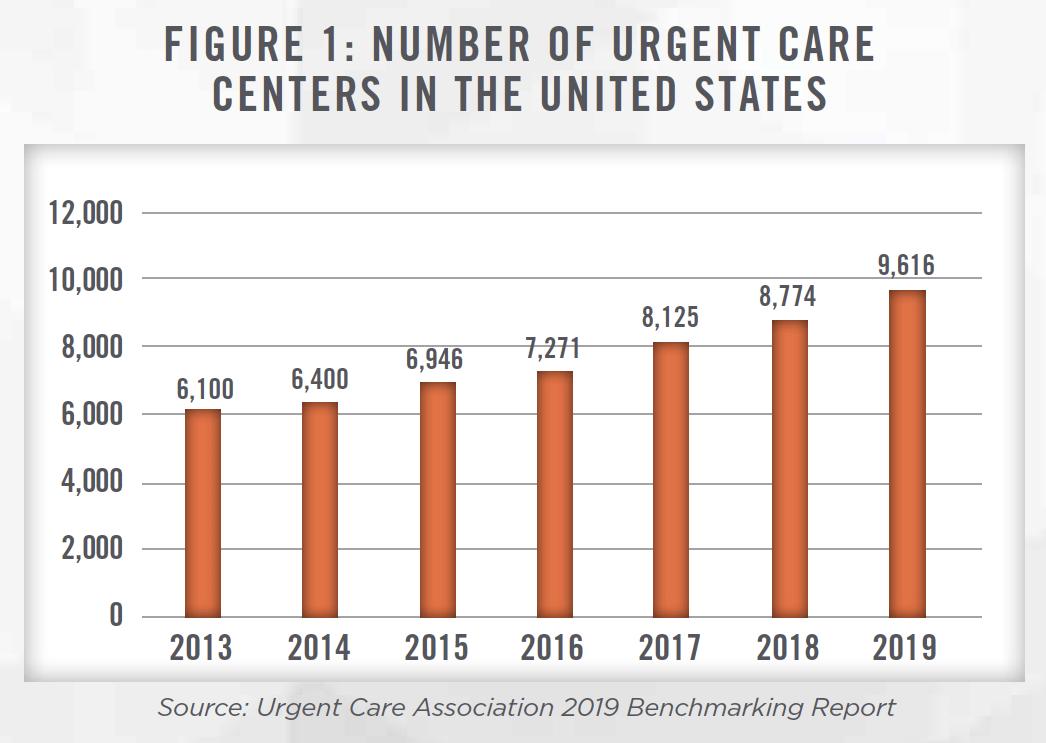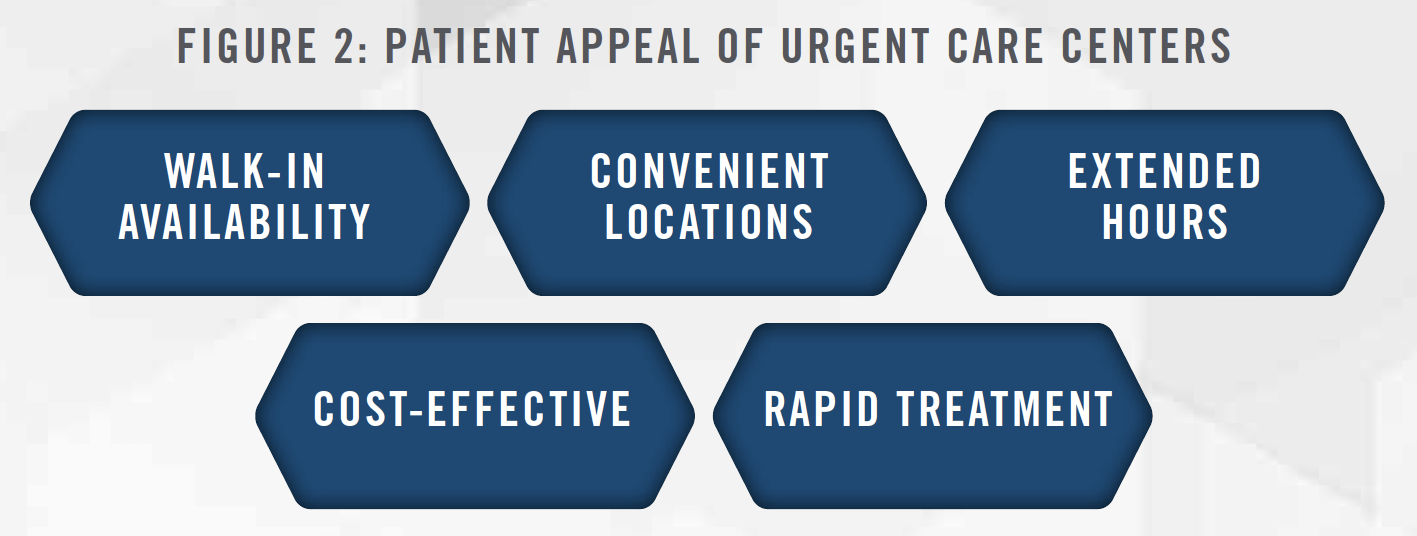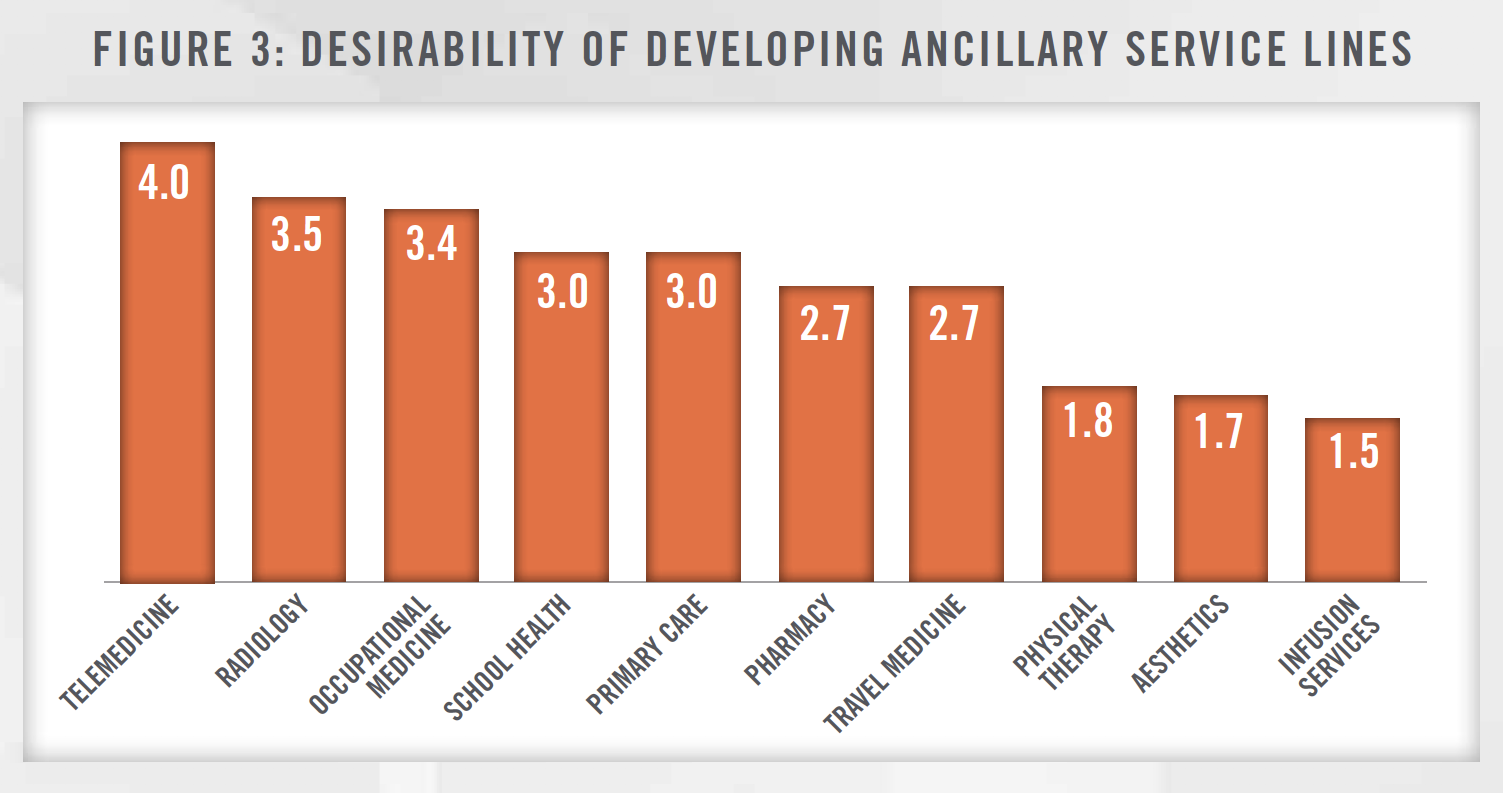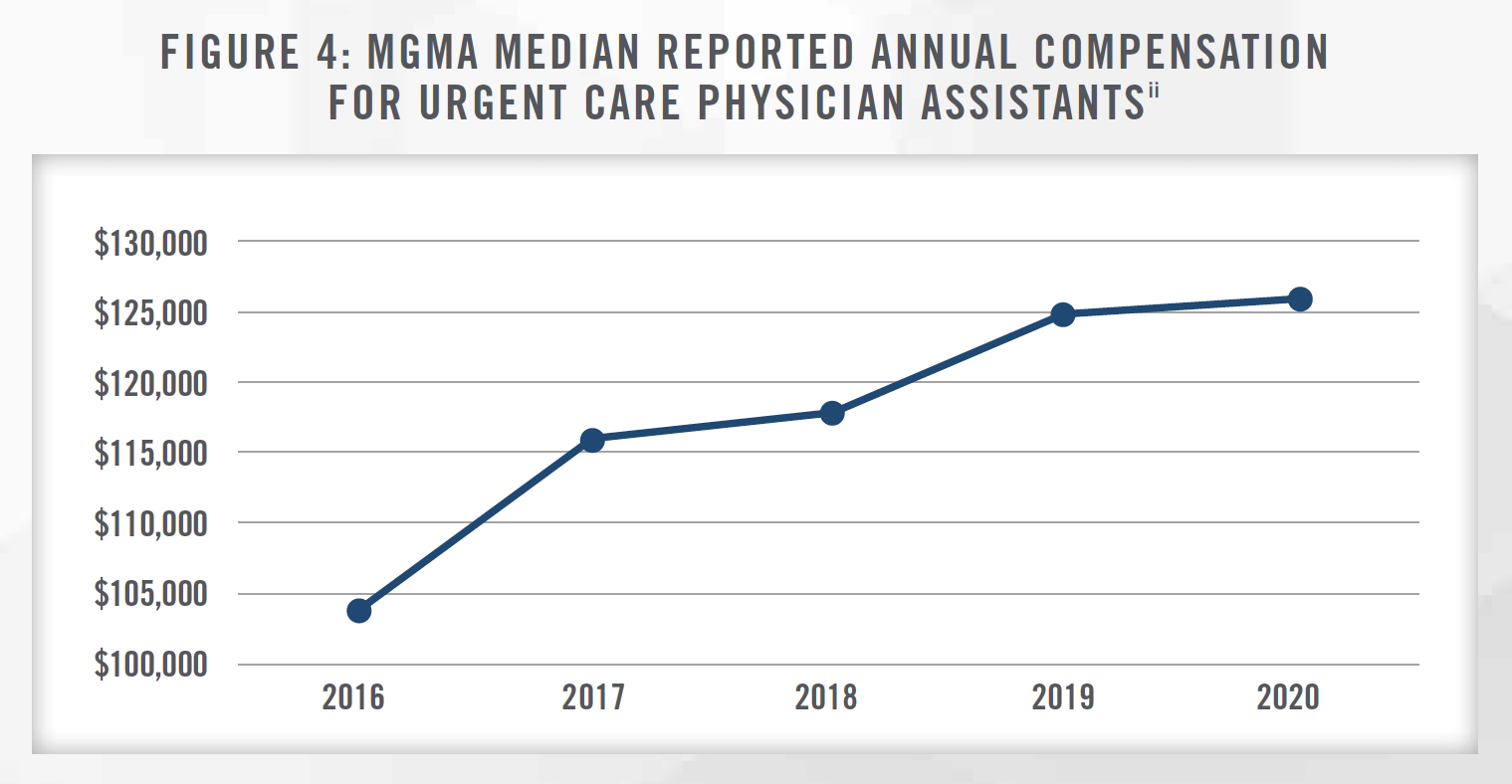The urgent care sector has been a quickly growing segment of the healthcare industry over the last several years, and HealthCare Appraisers has observed growth in transactions in this highly fragmented sector of the healthcare services industry. The segment has benefited from a focus on preventative care, changes in consumer preferences, and implementation of technology in healthcare. In this article we provide background information on the urgent care sector, timely factors affecting urgent care operations, transaction activity in the urgent care space, valuation considerations for urgent care centers, and how COVID-19 is impacting urgent care operations.
![]() BACKGROUND
BACKGROUND
Urgent care centers are outpatient facilities that provide a broad range of outpatient care to patients suffering from injuries, illnesses, and other healthcare issues that typically require an expedited visit by the individual to a healthcare provider. Urgent care centers are typically staffed by advanced practice providers, or physicians specializing in family medicine, internal medicine, or emergency medicine. As a result, urgent care centers do not treat patients in need of surgical procedures, or other high acuity health issues that could be life threatening (i.e., strokes, heart attacks, etc.). Examples of conditions treated by urgent care centers include lacerations, influenza, ear infections, and sore throats. While there are notable areas of overlap in urgent care centers and primary care medical practices, such as the types of providers staffing the facilities and types of ailments treated, urgent care centers provide the differentiating factors of typically having longer business hours, are usually open on weekends and holidays, and provide availability without needing to schedule an appointment.
![]()
![]()
![]()
![]()
![]()
![]()
![]()
![]()
As shown in Figure 1, the number of urgent care centers has grown from approximately 6,100 in 2013 to over 9,600 in 2019.


While there are many reasons behind the increase of urgent care centers over the last several years, based on urgent care centers appraised by HealthCare Appraisers, we have noted that changing consumer preferences have been a notable positive impact on this sector. Urgent care centers are increasingly functioning as more than a facility for patients to access a provider quickly, without an appointment, or on evenings and weekends. Increasingly, individuals are using urgent care centers as a replacement for their primary care provider. Adding to the convenience of an urgent care center as a healthcare option is its location. Unlike many physician practices, which are located in large medical office buildings or on a hospital campus, urgent care centers are usually found as freestanding buildings or in open-air shopping malls, resulting in more efficient patient visits. We have observed certain urgent care centers that seek to make the patient experience even more favorable, by focusing on items from comfort and visual appeal of their offices, to technology platforms that result in improved user experience for booking appointments and receiving test results, to cash-pay methods to keep pricing transparency as a focal point.


![]()
![]()
![]()
![]()
![]()
![]()
![]()
![]()
Another growing trend in the operations of urgent care includes urgent care and emergency departments under one roof. Operators such as Intuitive Health have partnered with health systems across several states in launching this concept over the past several years. Continuing with urgent care’s focus on patient convenience, combined centers under this model allow patients to receive care in the appropriate setting, without needing to choose whether to visit an emergency department or urgent care center.
Many urgent care operators are attempting to differentiate their services by specializing in an urgent care niche. For example, PM Pediatrics, whose 51 pediatric-focused locations in January of 2020 represented an increase of 34 percent as compared to the prior year.[i] Still, other operators focus their efforts on urban markets, while others may target certain demographics, such as cash-paying millennials. As the number of urgent care locations continues to grow, competition will continue to push operators towards defining their differentiating factor.
Clinical service offerings are one way to expand services and offer differentiation from peers. HealthCare Appraisers surveyed professionals familiar with urgent care center transactions, including investment bankers, urgent care operators, and health system business development professionals. In our survey, we asked them to rank, on a scale from 1 to 5 (5 being the most desirable), the relative desirability of developing complementary service lines at their urgent care centers, which are outlined in Figure 3.


We note that we gathered these responses before the impact of COVID-19 that began in the spring of 2020, and yet telemedicine was the top desired offering.
![]()
![]()
![]()
![]()
![]()
![]()
![]()
![]()
Many urgent care center staffing models rely heavily on the use of advanced practice providers (“APPs”), given this approach is typically less expensive than staffing centers with physicians. However, we have observed an increased demand for APPs across the healthcare services industry. Increased demand for APPs is the result of many trends in patient care. An increased focus on preventative care has resulted in an increased use of APPs in primary care. The rise of telehealth platforms has resulted in APPs playing a key role; a non-provider may gain information on a patient, and then refer the patient to either an APP or physician depending on the severity of the patient ailment, which can help minimize provider costs. While there are many other reasons for increased demand of APPs, we have observed a resulting increase in APP compensation, as competition for these providers continues. As outlined in Figure 4, median compensation for physician assistants in the urgent care space has increased over 20 percent in the last several years.


Many urgent care centers have been negatively impacted as a result of the COVID-19 pandemic. Declines in volume at urgent care centers can be tied to several factors. Certain ailments often treated in urgent care settings that usually occur as a result of social activity, such as sexually transmitted diseases, minor injuries from organized sports, or bacterial or viral infections not related to COVID-19, are less likely to occur as people isolate themselves at home. Additionally, people with minor ailments may assume urgent care centers are being frequented by individuals with COVID-19 symptoms, and would prefer to stay away from such populations, despite the potential determents of leaving their ailment untreated. The quickly rising telemedicine industry may also be siphoning patients from urgent care centers, as patients can receive care in the comfort of their home and talk to a provider via phone or through a video screen conversation. Many telemedicine platforms offer this service 24 hours per day, which paired with receiving care in the comfort and safety of one’s home, provides a compelling healthcare alternative to urgent care centers.


Despite challenges, the urgent care industry has attempted to soften the blow of decreased patient volume. Many centers have embraced COVID-19 testing at their facilitates, which is a test that cannot be done via a telemedicine visit. Additionally, many urgent care operators have added telemedicine offerings to stay competitive during the pandemic. Experity, a company that provides software programs for the urgent care industry, launched a telemedicine application for the industry in March, up from its original launch date that was planned for the end of 2020. Experity also produced a COVID-19 testing app in three days, which was launched in March. In a survey by the Urgent Care Association of approximately 1,100 urgent care centers, 85 percent responded in May 2020 that they were providing telemedicine services, up from 29 percent in 2019.[iii]
![]()
![]()
![]()
![]()
![]()
![]()
![]()
![]()
Investors in urgent care centers can span a wide array of organizations, including providers, insurance companies, health systems, and private equity sponsors. On the private equity side, the fragmented industry has drawn the interest of these investors, who have been actively involved in the space for many years. The fact that many urgent care businesses can range from a single location to dozens of locations, allows investors to purchase a larger, multi-location urgent care operation, and flexibility to subsequently roll-up acquisitions, or expand through de novo center openings. Some private equity investors have already exited from their initial investment, and sold to another firm or health system. For example, Summit Partners, which invested in CityMD when it had 8 locations in 2014, sold the business in 2017 to Warburg Pincus, after having expanded to 68 locations. In 2014, Endeavor Capital made an investment in Oregon based Zoom+Care when it had 23 locations, expanding to 37 locations before the company was acquired by PeaceHealth in late 2018.[iv]
Health systems continue to have an interest in investing in the urgent care space as well, continuing with their investment in outpatient centers and provider networks. In 2019, HCA Healthcare purchased 24 MedSpring urgent care centers from Fresenius. The transaction expanded HCA’s urgent-care locations to 160, which operate under the CareNow brand.[v] Many health systems are leveraging the expertise of urgent care operators to manage their centers under a joint venture model. Dignity Health, (now CommonSpirit), one of the nation’s largest health care systems, formed a joint venture with GoHealth Urgent Care, one of the largest urgent care operators in the country.
While the substantial transaction activity in the urgent care industry is notable, much of the industry’s growth has been derived through de novo center expansion. 75 percent of professionals we surveyed indicated they preferred pursuing de novo opportunities as compared to established center acquisitions. 70 percent of these individuals also reported that competition for acquisitions was unchanged year-overyear, despite 80 percent indicating observing an increase in transaction activity year-over-year.
![]()
![]()
![]()
![]()
![]()
![]()
![]()
![]()
While transaction activity related to urgent care centers has been robust in recent years, terms of the vast majority of transactions over the last several years remain publicly undisclosed. In our survey of industry professionals, 40 percent responded their typical observance of total invested capital-to-EBITDA multiples for controlling interests in single-location urgent care centers ranged from 5.0x to 5.9x, and 80 percent of respondents indicated that a multiple of EBITDA is the primary measure considered when determining the purchase price of an acquisition candidate. Larger acquisitions can certainly command higher valuation multiples. In 2017, Concentra Group Holdings, an occupational medicine and urgent care provider, entered into an agreement to acquire U.S. HealthWorks, an operator of over 200 occupational healthcare centers, from Dignity Health (now CommonSpirit). Dignity Health held a 20 percent ownership interest in the combined Concentra and U.S. HealthWorks entity post-transaction. The transaction valued U.S. HealthWorks at $753 million.[vi] U.S. HealthWorks’ adjusted EBITDA was $63 million in 2017, which implied an EBITDA valuation multiple of approximately 12.0x.[vii]
It is important to note that the size, scope, and financial condition of one urgent care business can vary quite differently from another, which in turn can affect the implied valuation multiple that is paid for the business. For example, an urgent care business with dozens of busy, well-run locations may attract a higher valuation multiple as a platform investment target, as compared to single-location urgent care center. In our survey of industry professionals, the median reported EBITDA margin was 20 percent that respondents observed across their center locations, though responses ranged from 15 percent to 35 percent. Many items can vary the financial condition and outlook from one urgent care center to another, which affects an investor’s view of the attractiveness of a particular center. Some examples include:
![]()
![]()
![]()
![]()
![]()
![]()
![]()
![]()
![]()
![]()
![]()
![]()
![]()
![]()
![]()
![]()
![]()
![]()
![]()
![]()
While these are just some examples, they demonstrate that many variables need to be carefully observed and considered when evaluating an urgent care center. Factors specific to the individual business operations as well as local economic and competitive conditions, should all be carefully reviewed.
![]()
![]()
![]()
![]()
![]()
![]()
![]()
![]()
The urgent care sector has remained a popular investment area for many years and continues to grow rapidly. Despite active merger and acquisition activity over the years, the space is still highly fragmented. While short-term challenges such as COVID-19 have emerged, urgent care providers have responded quickly to adapt. As primary care and preventative care continue to attract national focus as tools to help prevent public health crises, we expect investment and innovation in the urgent care sector to continue. Given that the size, scope, and economics of an urgent care business can vary significantly, it is important that industry operators rely on an appraiser who understands the nuances of urgent care business models for their transaction needs.
[i] Urgent Care Association, “2019 Benchmarking Report”
[ii] Medical Group Management Association, 2016 through 2020 Provider Compensation and Production Reports: Based on 2015 through 2019 Survey Data (“MGMA”).
[iii] Castellanos, Sara, The Wall Street Journal (Digital Edition), “Urgent Care Clinics Turn to Technology to Meet Coronavirus Challenge.” June 11, 2020; accessed August 3, 2020 from: https://www.wsj.com/articles/urgent-care-clinics-turn-to-technology-to-meet-coronavirus-challenge-11591907373
iv Cain Brothers press release, January 7, 2019, accessed August 20, 2020: https://www.cainbrothers.com/wp-content/uploads/Zoom-External-Deal-Announcement-FINAL.pdf
[v] Kacik, Alex. Modern Healthcare, “HCA buys two-dozen urgent-care centers from Fresenius Medical Care.” July 2, 2019, accessed on August 3, 2020 from: https://www.modernhealthcare.com/operations/hca-buys-two-dozen-urgent-care-centers-fresenius-medical-care
[vi] Concentra press release, Definitive Agreement to Combine Concentra and U.S. HealthWorks, October 23, 2017, accessed August 20, 2020 from: https://www.concentra.com/resource-center/press-releases/definitive-agreement-to-combine-concentra-and-us-healthworks/
[vii] Select Medical Presentation: Bank of America Merrill Lynch Leveraged Finance Conference, December 2019, accessed on August 20, 2020: https://www.selectmedical.com/-/media/project/selectmedical/dotcom/usa/page-assets/media-and-news/documents/bank-of-america-leveraged-financeconference-presentation-2019.pdf?t=20191210151432

